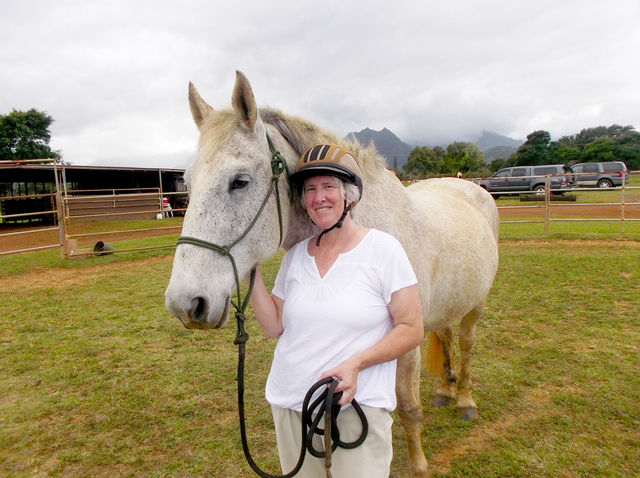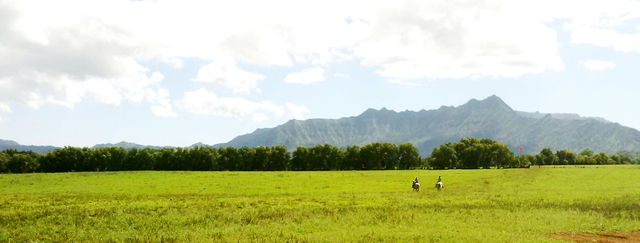Sitting in the saddle on top of a horse is completely different than jumping in a car, turning the key and heading out on the highway. Kauai visitors and residents drive by Princeville Ranch on the idyllic North Shore every
Sitting in the saddle on top of a horse is completely different than jumping in a car, turning the key and heading out on the highway. Kauai visitors and residents drive by Princeville Ranch on the idyllic North Shore every day, and some of them venture in, like I did recently, to check out what is offered there for riding lessons and horseback riding tours.
My first impressions: A relaxed herd of healthy horses, some saddled up ready for a group ride and some being tended to by quiet, focused staff, all set against a backdrop of a wide open vista of green, flowering trees and a dramatic mountain range.
I learned that Princeville lands were first grazed by cattle in 1831, making Princeville Ranch the oldest working cattle ranch on Kauai. Horses were introduced to Hawaii in 1840. The Spanish came over to teach Hawaiians how to ride horse to manage the free-roaming cattle. Hawaiian cowboys were called “paniolos,” derived from “espagnole,” meaning “Spanish.”
Today, Princeville Ranch occupies about 2,500 acres, with grass-fed cattle numbering around 300. With the Carswell family at the helm, the farm continues as a family-run enterprise, employing 75 staff and welcoming over 200 guests each day during the busy season, to the ranch which is now combined with a successful adventure company.
On my first visit, one of the guides was riding a horse in a slow circle in front of the tack shop while giving a simple series of “horse talk and safety” directions to an experienced horsewoman prior to the two of them heading out on a private trail ride to the waterfall. The woman’s husband and young daughter were going back to home base to have lunch and a nap during that time!
The following week, I returned and was introduced to Eileen Donohue, the equestrian supervisor. We had an immediate rapport and I felt inspired to arrange an hour-long private riding lesson with her. While I have learned a lot about communication with horses, it has been many years since I was on a horse and I am still a neophyte when it comes to riding. I have a healthy respect for the size and majesty of horses and would like to feel more confident and at ease when I am in the saddle.
Eileen assured me she guides many people in this way, beginning with some “ground work” followed by riding time in the round pen which is located away from the main road, closer to the mountains.
“It all begins on the ground, how we communicate with the horse,” she explained. “We want something that weighs this much to be on side with us. I want him to be a willing partner.”
Horse are “prey” animals, like deer, which means that for survival they depend on their keen sense, attuned to what is happening around them and how people are feeling. So they are sensitive to “mixed messages.”
For example, Eileen is often asked, “How do I ask my horse to halt?” And she explains, “It is all about internal energy. We’re all kind of pumped up and we’re physically leaning forward because we’re in a walk or a trot. And when you use your hands to bring the horse back, he’s very confused because he’s reading your body language, but your hand is restraining him, and so he’s wondering what you want him to do.
“So if we come down in transition, from canter to trot or trot to walk or walk to halt, we best be there in ourselves, internally, first. Horse’s breath usually follows your breath, his cadence follows your cadence.”
Eileen has learned from many horse people throughout her life, including Monty Roberts, a world-renowned horse trainer. She gave me an overview of her own training.
“I’ve been fortunate to be exposed to a lot of really good horse people. I came up riding hunter jumpers with George Morris, so that’s very classical training. I’ve ridden with David Carswell from this Ranch and Randy Reiman, who’s in Montana, who used to start the horses for Parker Ranch. He’s a wonderful clinician who travels all over.”
After my hour together with Eileen and Po the horse — who I was matched with based on my height, weight and his “horse-onality” — I felt enriched by a clearer understanding of how the horse responds to me, and rewarded by my first experience of truly feeling at ease in the saddle.
Eileen smiles as she tells me about her friendly reminder to riders heading out on the trail at Princeville Ranch.
“Remember to breathe! Let your hips sway with the horse, it’s the horsey hula. You have a horse partner to share the next two or three hours with you to have a good time. If you need help the guides are there as resources. The whole idea is to have fun! You’re on holiday — enjoy this!”
•••
Lynn Thompson is a resident of Canada who always enjoys visiting her friends on Kauai. She can be reached at LivingOnPurposeLynn.com




